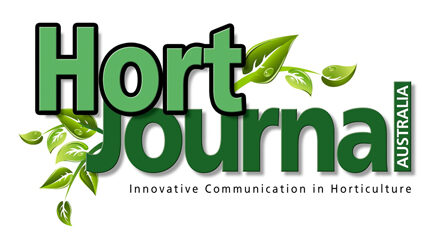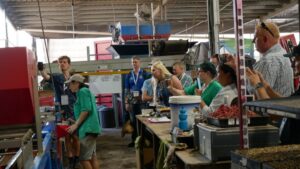
Propagation for conservation
By Karen Smith
The 53rd International Plant Producers Society (IPPS) conference ‘Propagation for conservation’ was held recently in Cairns at the Crystalbrook Riley Hotel with an extensive list of speakers and activities. Here is a snapshot of the event.
President, Clive Larkman, president of IPPS opened the conference and local MP Bree James welcomed the delegates to Cairns extolling the virtues of far North Queensland for business and tourism.
The horticulture industry response to environmental stress was an underlying theme to this conference and in the keynote address Prof Neena Mitter quoted Kirsten Schultz from WWF international saying ‘nature is issuing a distress call.’ The linked crises of nature loss and climate change are pushing wildlife and ecosystems beyond their limits, with dangerous global tipping points threatening to damage earths life-support systems and destabilise societies’. This sentiment was reinforced By Dr Alice Hayward highlighting the fact that Australia has one of the highest rates of species extinctions in the OECD, over 70% of these extinctions are plants.
Prof Mitter detailed conservation options such as preserving species in national parks in protected areas and natural biospheres, botanic gardens and seedbanks. Tissue culture was described by Prof Mitter as one cog in the mechanism to conserve recalcitrant or exceptional species, seedless crops, open pollinated crops, and endangered species. Tissue culture is a core technology for producing novel genotypes and speed breeding novel hybrids. Tissue culture methods have the advantage of being economical with source plant material where a single cutting of less than 0.5mm could be the source for 200 to 500 plants. According to prof Mitter, coupled with cryopreservation techniques, it is possible to transport plant material even to Mars.
Dr Alice Hayward described the devastating effect of Myrtle Rust on native plants in Australia and the part that tissue culture can play to preserve our unique species. This invasive fungal disease Austropuccinia psidii affects more than 380 Myrtaceaespecies leaving the plant unable to reproduce. It is feared that possibly more than16 species will be functionally extinct within one generation. In situ conservation is no longer viable for impacted Myrtaceaeand seed banking is also impacted.
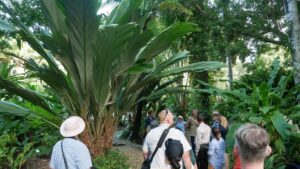
The University of Queensland in conjunction with the Queensland Alliance of Agriculture and Food Innovation (QAAFI) is one of several organisations nationwide developing cryobiotechnology methods to help fight this threat. Cryopreservation of living tissue in liquid nitrogen at -196⁰C is the goal providing low maintenance long term storage for any valuable horticultural crops. Dr Hayward described the results of one of the PhD students, Jingyin Bao who has successfully grown several species of plants propagated using tissue culture and cryogenically stored. Lenwebbia sp. Main Range and Decaspermum struckollicum among them, both critically endangered.
Dr Ranjith Pathirana from the New Zealand Institute for Plant and Food Research provided more background on cryopreservation describing two approaches. Controlled rate cooling, often used for winter dormant buds, and vitrification or the solidification of liquids without crystallisation forming a ‘glassy state’. Dr Pathirana explained how temperate plants have developed genetic, biochemical and physiological adaption mechanisms for extreme cold and how his researchers mimic these mechanisms making cryopreservation possible for any plant species.
Dr Rakhi Chaturvedi and Dr Jayeni Banderage outlined how tissue culture techniques can improve crops. Dr Chaturvedi discussed various advantages of tissue culture techniques including avoiding propagation from virus infected plant material and crop improvement.
Dr Hiti-Bandarage’s field of research facilitated the mass propagation of pomegranate using tissue culture. Dr Hiti-Bandarage outlined the export potential for pomegranate grown in far North Queensland to northern hemisphere markets during their non growing season. Pomegranate (Punica granatum L) of the family Lythraceaehas a history going back before 3000 BC. It is recognised as being high in fibre and vitamins and having anti-cancer and anti-inflammatory properties. Propagation using tissue culture is not seasonal and maximises use of starting materials. Plants are true to type, homogenous and vigorous. ‘Field trails under orchard conditions in far North Queensland were successful’ said Dr Hiti-Bandarage
Rising sea levels are gradually inundating coastal swamps and wetlands, leading to increased soil salinity and plant stress. Prof Prakash P. Kumar stressed the need for modern tools to increase the salinity tolerance of important plants such as rice. Soil salinity inhibits plant growth and yields worldwide. As possibly 50% of arable land worldwide may face salinity problems by 2050, Prof. Kumar stated the need to develop precision breeding strategies that enhance the salinity tolerance of plants for conservation and food security. The research focus has been on salt-tolerant plants such as the mangrove. Mangroves possess unique survival adaptations that enable them to thrive in saline environments. Prof Kumar explained how salt tolerance could be conferred to rice by introducing a mangrove gene. Understanding how these processes work will help generate future crop plant varieties with higher tolerance to abiotic stress.
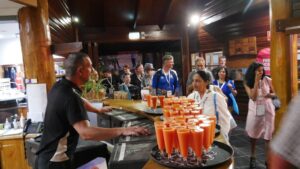
Modifying plants and crops may help some plants adapt to changing environments but preserving wild crop relatives is also important. Several presentations stressed how important it is for some species to be preserved in the wild.
Dr Nadesa Panicker Anil Kumar highlighted the importance of maintaining the wild relatives of cultivated crops having little genetic diversity. Dr Anil Kumar suggests these wild relatives are critical resources possessing valuable traits such as pest and disease resistance and adaptability to climate variation. He described an Indian farming model promoting an economy using small and marginal farms using cultivation practices avoiding hazardous chemicals, promoting a range of crops and biodiversity.
Ms Komal Goel had a similar message. Her research at RMIT (The Royal Melbourne Institute of Technology) was directed towards finding alternatives to cereal crops. Ms Komal Goel investigated quinoa and amaranth both being pseudocereals rich in health promoting properties. Ms Goel suggested that these pseudocereals could offer farmers a way to diversify their crops particularly as amaranth was a heat tolerant resilient crop whereas quinoa was resistant to cold, salt and drought.
Also on the subject of food crop alternatives, Yan Diczbalis from the Queensland Department of Agriculture and Fisheries described the possibilities provided by the commercial production of palms as a food source. He described palm hearts as a versatile gourmet product used fresh for salads or baked, grilled, roasted, steamed or boiled. Palm hearts consist of the stem, growing shoot and newly formed fronds. Approximately seventy palm species are commonly consumed around the world including Northern Australia and is a form of bush tucker. Yan highlighted the susceptibility of some palms to over-harvesting citing examples such as coconut (Cocos nucifera), jucara (Euterpe spp.), sago (Metroxylon spp.), and hurricane palm (Dictyosperma album). Jucara, sago and hurricane palm are under threat in their native environments. He recounted his success growing Pejibaye, also known as peach palm (Bactris gasipaes). This clumping palm can provide fruit but is also a sustainable option for palm hearts and is increasingly grown to conserve local palm species subject to extinction.
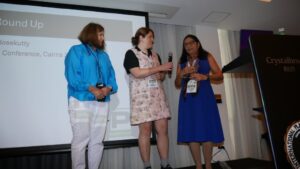
We live in a time of mass extinctions in our natural world and our flora are at particular risk. Natalie Valance, owner of Muchea Tree Farm, used statistics from the Department of Biodiversity Conservation and Attractions (DCBA) listing 163 critically endangered, 145 endangered, 130 vulnerable and 15 extinct flora species. She listed some strategies that could help conservation efforts. Using native, endemic species for mining revegetation projects, landcare revegetation, and landscaping. Involving interest groups, small landowners, retail markets and cut flower producers in native flora conservation. As a nursery owner she urged others at the conference to encourage others, especially, to educate, endure and protest things where we are able, if we want to ensure Australia’s rare and endangered species are not obliterated in our lifetime.
To conserve endangered species, you must know where they are. Brandan Espe from James Cook University explained his role in facilitating research on rare and endangered species in far North Queensland. Studying endangered species is difficult if you have to do it in isolated or hazardous locations. Brandan finds examples of rare and endangered species and brings samples back to researchers for more thorough investigation. These plants can be propagated in a controlled environment protecting them from climate risks, habitat degradation, fire risk or other threats with all location information and provenance.
‘Most of the plants in this program have less than 1000 individuals, there are ten species with less than fifty,’ said Brandan. The main objective of this program is to produce a sustainable, genetically diverse collection and re-introduce them into the wild.
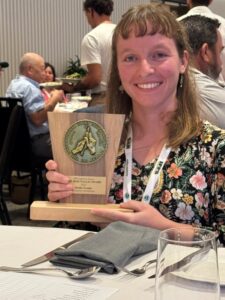
Dr Charles Clarke of Cairns Botanic Gardens provided a short history of the botanic gardens explaining the short comings of the current collection and the direction for the future. The Cairns Botanic Gardens, according to Dr Clarke, has had several iterations since its inception in 1886 having once been a market garden and even a zoo. Dr Clarke described the current garden as a botanic garden with a focus on exotic ornamental plants. Most plants have entered the collection with little planning or organisation from commercial sources. Poor record keeping over the years means that a significant part of the collection has unknown provenance and too many ‘junk’ plants affecting workflow. Having good data about plant source habitat increases the chances of successful propagation. Dr Clarke used the example of a Nepenthes treubiana sourced somewhat vaguely in New Guinea. A more systematic approach to plant propagation is required according to Dr Clarke.
Professor Davil Leung School of Biological Studies, University of Canterbury, NZ thanked his students for teaching him why plant cloning is important. Several native New Zealand plants are critically endangered and cloning specimens allowed students to carry out biological studies without harming natural populations. He used Leptinella nana L with less than 200 in the wild and Chordospartium stevensonii with one natural population as examples. Phyto-remediation was another example where cloning could produce large numbers of plants quickly for sites contaminated with heavy metals such as lead.
Two of the sponsors of the IPPS Cairns conference are local nursery owners who also provided an insight into the particular challenges of the wet and dry tropics.
Elaine Duncan, one of the owners of Flourish Plants, shared her local knowledge that has made Flourish Plants profitable despite challenges of weather variability and the continuing battle against pest and disease. ‘We have had no really dry season for a number of years’ said Elaine. Typically, the wet tropics region experiences up to two metres of annual rainfall falling mainly between November and April with average temperatures between 25⁰C and 30⁰C. The last four years has seen really overcast weather with high humidity, so we haven’t had the chance to dry out. Elaine and her staff hosted one of the nursery tours for the IPPS delegates, demonstrating the potting and transport preparations for her nursery products. Flourish Plants also, generously, sponsored the IPPS gala dinner
Candy MacLaughlin, general manager of Skybury Farms also told tales of flooding rains and crop losses. She related the effect of a one in one-hundred-year rain event in January 2024 that flooded the property, compacting the soil and gouging three metre ditches through parts of the plantation of papaya and coffee.
‘We lost roads, dams, topsoil, and thousands of papaya trees’ said Candy.
They have had the occasional outstanding successes such as hybridising amorphophallus and leaf cutting propagation of Amorphophallus titanium. The future direction of Cairns Botanic Gardens will reduce the reliance on commercial suppliers and shift towards a collection of known provenances from the wild.
Candy asked the question ’How do we become sustainable, long-term farmers?’ Farmers need to be all things from accountants and human resource specialists to agronomist, scientist and marketing expert. Being a negotiation specialist, logistics master and guidance councillor helps also. Size is not necessarily a good thing according to Candy, but she explained how vertical integration and diversification helped build a solid business. Waste products of papaya turned into vodka and coffee liqueurs in a collaboration with an Australian craft distillery, FNQ Distillery. The farm has a retail outlet and café tapping into the tourism market. Skybury farms hosted a very informal, relaxing networking dinner at the end of the nursery visits in the Atherton tablelands on Day one. Delegates had the opportunity to taste some of their delicious products.
Dr Puthiyaparambil Josekutty, convenor of the Cairns conference, leads the research lab at Skybury Farms. Establishing a tissue culture lab became essential when a sudden change in government policy restricted the import of papaya seeds. Skybury Farms has two tissue culture labs, one dedicated to research and development, and the other to production.
Candy and her brother Mark MacLaughlin are second-generation farmers at Skybury Farms, and another nursery owner, Tony Van der Staay from Westland Nurseries in Hobart, introduced the next generation to manage his nursery just in case he, metaphorically, ‘kicked the bucket’. It is refreshing to see younger generations moving into management roles as older leaders take a more backseat approach. Tony reinforced the idea that nursery managers, like other farmers, needed to wear many hats. Efficiency boosts come from attention to detail, and small daily actions can have a big business impact.
Mark Van der Staay and Gabriella Lee described some useful office tools simplifying payroll systems, cost control, invoicing, and stock control. Evolving sales strategies using streamlined sales methods and batch control, generating easily interpreted picking lists, had simplified online orders and facilitated picking at the nursery. Tony also advocated for clear bay markings for plant storage and the application of barcodes during the potting stage.
Some things are difficult to automate. Des Boorman, an active plant breeder with a Bachelor of Applied Science degree, shared his passion for wildlife and plants while he provided tips on preparing grafts. Des provided a thorough treatment of the “sexy” art of grafting. Des is a real specialist, demonstrating his custom tools and grafting technique, which sometimes required a grafting shirt with one long sleeve and one short. A well-designed grafting workspace, where all tools and materials are within easy reach, will increase the number of successful grafts, thereby increasing productivity and reducing fatigue, according to Des.
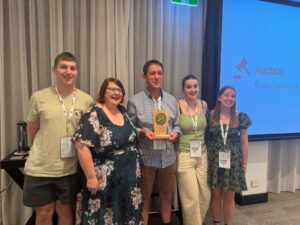
‘What are the five rules of propagation? ’ Des asked, and Elaine Duncan recited the mantra, ‘Hygiene, hygiene, hygiene, hygiene, hygiene’.
Using separate tools for different nurseries and even for root stock reduces the opportunity for contamination. Workbenches, says Des, are another possible source of contamination. Methylated spirits diluted in water is an effective disinfectant for tools, and Des recommended frequent use during a grafting workday. Handling pots, trays, and soil is another possible source of contamination that affects grafts and personal hygiene; frequent hand washing minimises the risk. Des used his wildlife media during his presentation, interspersing it with his tips and tricks, in what was a highly entertaining and engaging presentation.
Managing tissue culture, grafting, and marketing is the frontline for nurseries, but there is an army of backroom support and research dealing with many aspects of the nursery industry. Conferences are an ideal way to bring these fields together. Dr Tony Arioli, Seasol; Daniel Docherty, Syngenta; and Zen Kynigos, Prodoz, sponsors of the IPPS conference, presented recent research on the effects of these aids on plant growth. Dr Arioli summed up the benefits of using a bio-stimulant, improving plant response to stress, and Daniel Docherty outlined the effects of targeted amino acids on plant growth and performance in the nursery. Zen Kynigos described how plants access nitrogen and the benefits of using a form of nitrogen that plants can use readily.
Peter Howe, coordinator at Geographe Community Landcare Nursery in Western Australia, addressed a different problem faced by rehabilitation and revegetation sites. Peter’s research focused on root nodule bacteria (RNB) for native legumes in Western Australia, which assist in nitrogen use. He described the search for species of RNB from undisturbed woodland and the effect of inoculating native legumes with the bacteria.
Professor Tripti Singh from the National Centre for Timber Durability and Design Life in Australia presented a case for sustainably managed forests and the use of timber. There are about two million hectares of plantation forest in Australia, providing most of Australia’s sawn timber and pulpwood. These trees are primarily Radiata pine and its hybrids, as well as some hardwoods, such as Eucalyptus nitens. Of the approximately 122 million hectares of publicly owned (mainly Eucalyptus species), only a small proportion is available for commercial harvesting. Professor Singh stressed that the forest and wood industry is a sustainable industry and improvements to timber durability will maximise the use and re-use of timber.
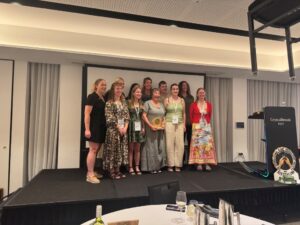
Many Australian nurseries have solar power installations, and Dr Vinod Gopal, representing Energy 24by7, explained how battery systems and solar panels can help reduce energy costs. Dr Gopal explained how solar-battery systems can be helpful in stand-alone situations such as mobile ambulance units.
Tania Harman from PWC offered advice for claiming a part of the Federal Government’s $4.7 billion set aside for R&D. ‘The tax incentive is broad-based to apply to all industries, ’ she said. ‘Tax-eligible R&D can be found where companies are creating new or improved materials, products, devices, processes or services.’
The Rod Tallis Award recognises the efforts of the younger sector of the industry. The winner in 2025 was Bridie Franks, who researched alternate potting media for deflasking tissue-cultured kalanchoe and echeveria. Like many in the horticulture industry, Bridie explored several career options before deciding to pursue a career in horticulture. The research she presented at the Cairns conference detailed her trial of four different media types for the two sample species. She outlined her methods and plans for data collection, but she didn’t allow for input from wildlife, particularly Corellas, who “munched up” her trial.
In a ‘live-streamed’ presentation, Prof Sadanand Dhekney described his plant trials aimed at optimising the production of Cannabis sativa in the USA. He defined the difference between ‘industrial hemp’ and ‘medical cannabis’ and marijuana. Essentially, the difference depends on the level of tetrahydrocannabinol (THC) in the plant. Industrial hemp is a legal crop in the US with a market of about US $820 million annually. Like all crops, cannabis has its share of diseases and virus’ and according to Prof Dhekney, tissue culture propagation methods are the easiest way to manage these risks. He described his methods for producing male flowers on female plants promoting self-pollination by using phytohormone manipulators.
Prof Nitri Mantri from the School of Science, Royal Melbourne Institute of Technology (RMIT) described evolving pathogen detection methods that will reduce the cost and increase the efficacy of current test methods. ‘The global trade in nursery stock’ he said, ‘creates a path for introduced pathogens in Australia’.
The future of pathogen detection may involve the detection of DNA or proteins. Prof Mantri outlined tests similar to COVID detection tests we endured some years ago to smartphone-based tests using large databases and artificial intelligence. AI-based systems have the potential for integration with autonomous nursery operations.
The Six Pack concept has been part of IPPS conferences since 2003, funded, in part, by the Gala Dinner Auction but mainly by corporate sponsorship. Garden City Plastics was this year’s sponsor.
The Six Pack team are selected from nurseries across Australia and includes horticulturists from the South African Exchange, who this year were Franzel Gruber (South Africa) and Chloe Bawden (Australia). Franzel and Chloe both provided a summary of their experiences gained during the exchange.
There could hardly be a better incentive program than the Six Pack program for young horticulturists. If you haven’t applied for next year, start thinking about it now.
The conference was a packed schedule of informative speakers and interesting site visits and tours. A conducted tour of the Flecker Botanic Gardens put the presentation by Dr Clarke into perspective, allowing us to see first-hand the challenge of reinvigorating the botanical collection.
Riding a cable car above the rainforest canopy was undoubtedly a more interesting way to reach our connection in the Atherton Tablelands – Flourish Plants and Skybury Farms, rather than by bus.
Delegates also had the option of a preconference tour that incorporated Port Douglas and its rainforest surrounds, as well as an organised golf competition.
As I was unable to attend the final tours Caleb Roberts from Daley’s Nursery has enlightened us with the following.
‘We concluded the conference with an afternoon bus trip MC’d by Des Boorman, and he was as entertaining as his presentation. We went past Walsh’s Pyramid, a spectacular natural formation south of Gordonvale and through a stunning sugarcane landscape. Stopping for lunch at Babinda Boulders we ran into Cadel Boyce from Cairns Botanic Gardens, gathering material with Brandon Espe who gave us a quick guided tour of the walking track which had fascinating plants like the Atractocarpus hersutus, Rhistantia pakosperma, acid drop vine, Garcinia warrenii and Musa banksii..
Our first nursery visit was to Palmer’s Wholesale Nursery, an adorable palm and cycad plantation run by father and son team, John and Johnathn Woodbridge. 18 months after inheriting the business, they have spent the time identifying areas for improvement and shared some of their grand plans with us on the day. It will be exciting to see how they progress.
The next stop was a visit to Daradgee Wholesale Nursery. Nursery Manager, Garth (Pernase has been on the property since he was six months old. We had a lovely sunset walk through their shade houses and saw plants destined for the indoor trade and were showing off foliage and colour in full force. We discussed modifications he has made to adapt to the constant wet season, such as extremely free draining mixes, and cyclone proofing the infrastructure by using very light shade cloth.
The bus rides were hubs of networking and discussion. Everyone split into groups for dinner with plans to gather in Hobart next year!
The following people were presented at the gala dinner:
Rod Tallis Award – Bridie Franks, TAFESA
Steve Vallance Tankard Award – Ray Parker, Parkers Nursery, NSW
Award of Honour – David Daly, Conifer Gardens, VIC
Edward & Mary Bunker Award – Di Larkman, Larkmans Nurseries, VIC
Hort Journal/Anita Boucher Memorial Award – Prof. Neena Mitter, Charles Sturt University, NSW
